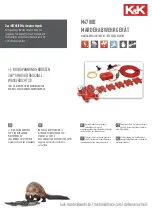
page 13
Operating Information
SECTION 3
3.1 Meter Mechanical Zero
With the gauge in its normal operating position (AC power removed), check that the meter pointer
covers the Dot at right-end of the dial face. If the Dot is not covered by the pointer, adjust screw
at the front of the meter until the pointer covers the Dot.
3.2 AC power Input
Connect the plug end of power cable into a single phase 115 or 230 V, 50/60 Hz power source (as
per unit configuration). When replacing the power cords standard plug with a plug to match a
particular system, care should be taken to connect the new plug in accordance with the terminal
block connections listed in section 2.4 of this manual.
3.3 Pressure Measurement
Connect gauge tube cables octal socket onto the octal base of a gauge tube installed in vacuum
system. The gauge will display the system pressure on the meter dial face. To check the accuracy
of the gauge, perform the required operations as specified in section 3.5 of this manual.
3.4 Controller Set Points (CVT units only)
The CVT series vacuum controllers, are provided with either single or double set points. On a
single set point controller, the right-front panel knob allows the user to adjust or position the
RED pointer on the dial face where a desired control function will occur.
On the double set point controller, the left-front panel knob is added to allow the user to adjust or
position a second RED pointer on the dial face where a desired control function will occur.
On those controllers configured with two front panel knobs; the left knob controls the LO Set
pressure (Relay K1), and the right knob controls the HI Set pressure (Relay K2).
Control logic determines that a relay will (energize) when the indicated pressure is lower than the
set-pressure, and de-energize when the indicated pressure is higher than the set-pressure or if their
is a loss of AC power to the unit.
3.5 Operation And Performance Check
All Hastings vacuum gauges, controllers, and tubes have been carefully calibrated and checked at
the factory before shipment. When a operational check or calibration is desired, refer to the
procedure outlined in this section.
The simplest and quickest way of checking the operation and performance of a gauge and/or gauge
tube is to maintain a new or known-good gauge tube on hand for use as a Reference. To check
operation, install both the Reference and suspect gauge tubes in a common vacuum system (locate
the gauge tubes as close as possible to each other), then evacuate the system until a stable base
pressure is obtained. Alternately connect the vacuum gauge to each gauge tube and record its
pressure readings. If the gauge tube-under-test produces a higher pressure reading than the
Reference gauge tube, this indicates a calibration shift and is usually the result of contamination
(particulate, oil, or other chemical deposits). You can try to restore calibration of the contaminated
gauge tube by cleaning it internally with an appropriate solvent such as high-purity isopropyl
alcohol (flood interior cavity of gauge tube gently with solvent and allow it to stand and soak for
about 15 to 30-minutes). Drain the contaminated solvent and let gauge tube dry in ambient air
until all of the cleaning solvent has evaporated. To prevent mechanical damage to the thermopile
elements, do not use forced air to dry the gauge tube. Gauge tubes that remain out of calibration
after cleaning should be replaced.
Содержание CVT-14/24
Страница 1: ...page 1 VT CVT SERIES VACUUM GAUGES and CONTROLLERS HASTINGS INSTRUCTION MANUAL ...
Страница 4: ...page 4 ...
Страница 6: ...page 6 ...
Страница 12: ...page 12 ...
Страница 16: ...page 16 Maintainance and Repair 4 3 ...



































